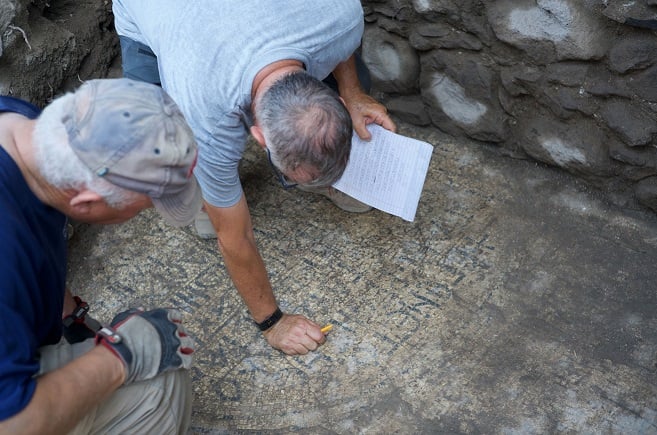
A 1,500-year-old mosaic inscription discovered recently in what was the city of Bethsaida, Israel could be proof that the place was once the home of the apostles of Jesus Christ, Saint Peter and Andrew.
Archeologists from Kinneret College in Israel and Nyack College, NY, led by Prof. Mordechai Aviam and Prof. Steven Notley, have recently uncovered a large Greek inscription during excavations of what is being called the “Church of the Apostles,” a Byzantine period basilica at el Araj/Beit haBek.
The translation of the inscription bolsters the basilica’s identification with the church described by the eighth-century bishop of Eichstatt, Willibald, the first known Englishman to visit the Holy Land, who reported a church built over the house of Saint Peter and Andrew in his travel logs.
While traveling from Capernaum to Kursi, Willibald stayed overnight at a place he was told, “is Bethsaida from which came Peter and Andrew. There is now a church where…their house [previously was].”
Greek inscription mentions Saint Peter Apostle of Jesus Christ
The inscription was translated by Prof. Leah Di Segni of Hebrew University and Prof. Yaakov Ashkenazi of Kinneret College in the latest press release of the excavation project, which explains the findings of the season.
It references a donor, “Constantine, the servant of Christ,” and continues with a petition for intercession by Saint Peter, “chief and commander of the heavenly apostles,” a title routinely used by Byzantine Christian writers to refer to the Apostle Peter.
Framed with a round medallion made of two lines of black tesserae, the inscription forms part of a larger mosaic floor in the church’s sacristy that is partly decorated with floral patterns, the excavation project’s announcement explains.
“This discovery is our strongest indicator that Peter had a special association with the basilica, and it was likely dedicated to him,” said Steven Notley, academic director of the dig. “Since Byzantine Christian tradition routinely identified Peter’s home in Bethsaida, and not in Capernaum as is often thought today, it seems likely that the basilica commemorates his house.”
In search of ancient Bethsaida
The El Araj Excavation Project is a joint project of the Kinneret Institute for Galilee Archeology at Kinneret College and Nyack College, sponsored by the Center for the Study of Ancient Judaism and Christian Origins (CSAJCO), the Museum of the Bible, the Lanier Theological Library Foundation, and HaDavar Yeshiva (HK).
“One of the goals of this dig was to check whether we have at the site a layer from the 1st century, which will allow us to suggest a better candidate for the identification of Biblical Bethsaida,” says archaeologist Mordechai Aviam, archaeological director of the excavation.
“Not only did we find significant remains from this period, but we also found this important church and the monastery around it” he adds.
Last lost city of the Bible
The press release points out that so far, the Roman remains that have been excavated at el Araj bear witness to the testimony of Flavius Josephus in Jewish Antiquities that the village became a small polis called Julias which existed until the 3rd century AD.
Altogether, these findings continue to strengthen the identification of el Araj/Beit haBek with the ancient Jewish town of Bethsaida, the last lost city of the Bible.
According to the New Testament, Bethsaida was the hometown of the apostles of Jesus Christ, Saint Peter, St Andrew, and St Philip where Jesus reportedly restored a blind man’s sight at a place just outside the ancient village (Gospel of Mark) and miraculously fed five thousand nearby (Gospel of Luke).
Three places have been considered as the possible location of Biblical Bethsaida, namely the Bedouin village of Messadiye; the deserted settlement of El-Araj; and the archaeological site of Et-Tell.
See all the latest news from Greece and the world at Greekreporter.com. Contact our newsroom to report an update or send your story, photos and videos. Follow GR on Google News and subscribe here to our daily email!



